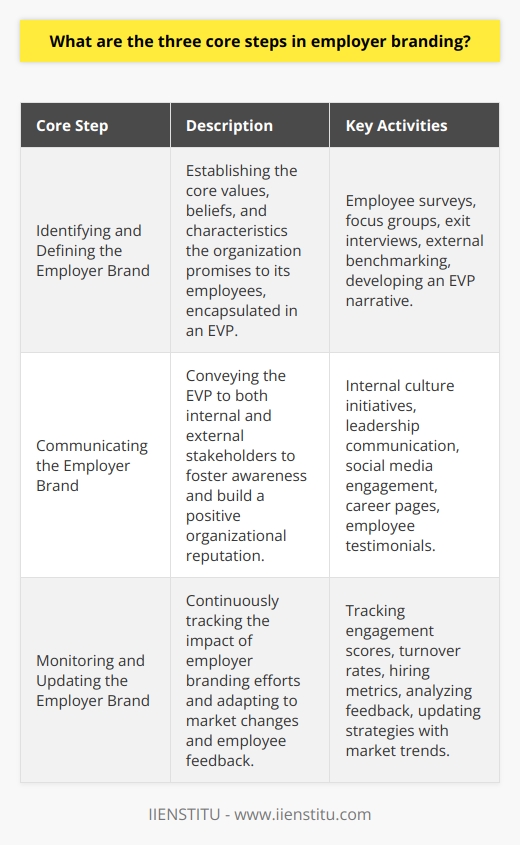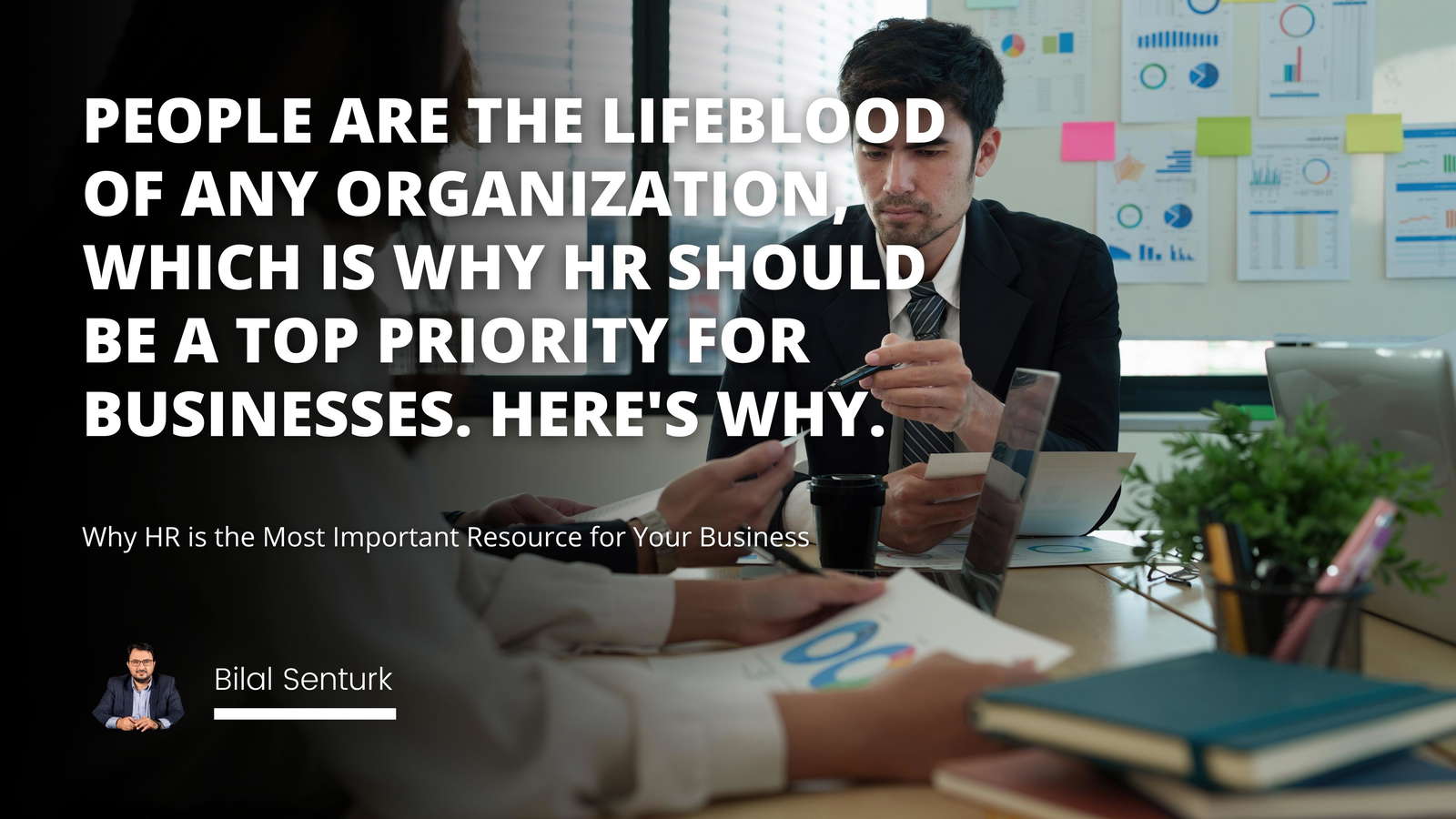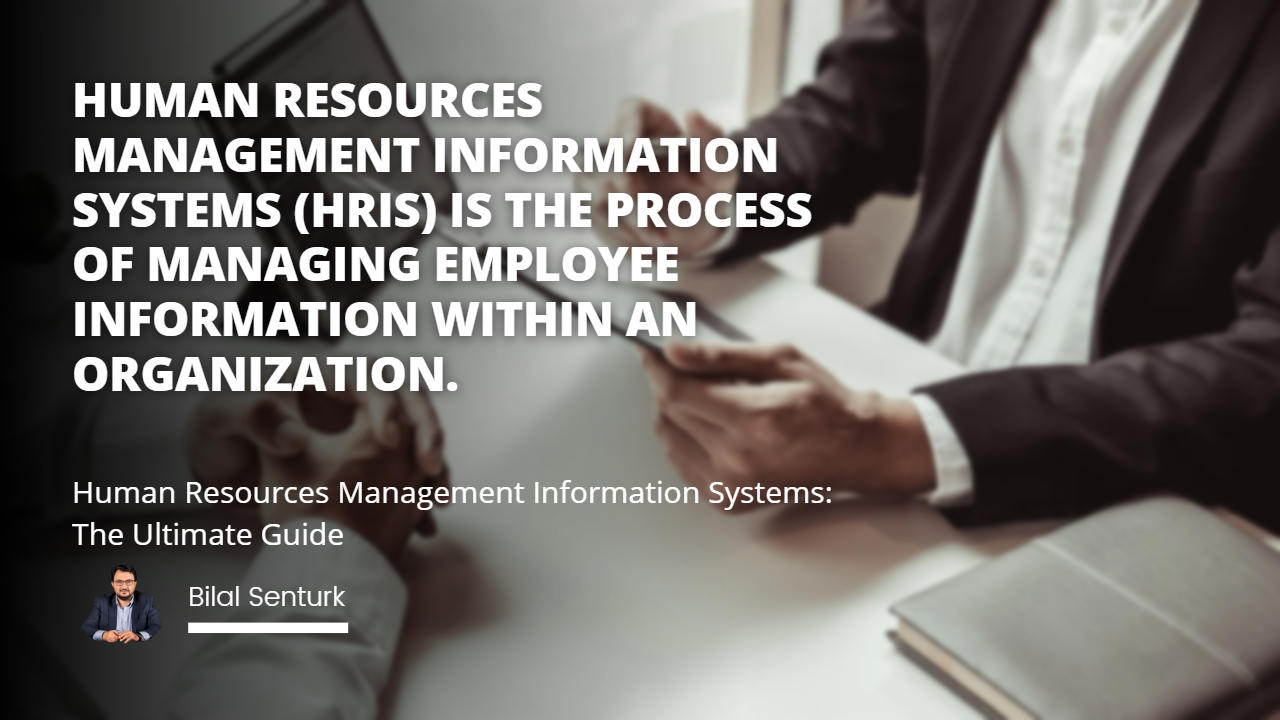
This article provides a comprehensive overview of employer branding, a relatively new concept in human resource management. It defines employer branding, outlines the steps to create a compelling employer brand, and discusses the elements of a successful employer brand. Employer branding can provide functional, economic, and psychological benefits to both employers and employees, such as increased employee loyalty, improved employee retention, and increased employee engagement.
Related Course: Hr Certification Course
Creating a compelling employer brand includes developing a value proposition, marketing the offer to external customers, and making internal marketing of the employer brand. In addition, a successful employer brand has competitive advantages, aligned values, and a positive reputation.
Introduction
Definition of Employer Branding
Benefits of Employer Branding
Steps to Create an Effective Employer Brand
Develop a Value Proposition
Employer Branding: A Comprehensive Overview
The concept of employer branding is relatively new, but it has already garnered considerable attention from organizations. Ambler and Barrow (1996) first introduced the idea, testing the application of different brand management techniques to the context of human resource management.
Research has shown that employer branding provides both employers and employees with functional, economic, and psychological benefits. Organizations can use employer branding to differentiate themselves as employers, aiming to attract and retain top talent.
This article provides a comprehensive overview of employer branding, including the steps to create a compelling employer brand, the elements of a successful employer brand, and the benefits of employer branding.
I. Introduction
A. Definition of Employer Branding
Employer branding creates a unique and differentiated employer image to attract, retain, and motivate top talent. It is a strategic approach to human resource management that uses marketing techniques to create a positive perception of an organization as an employer. Employer branding is not only about attracting potential employees but also about creating a committed and loyal workforce.
B. Benefits of Employer Branding
Employer branding can provide several benefits to organizations. First, it can help organizations differentiate themselves as employers and create a positive reputation among potential employees. This can lead to increased employee loyalty and improved employee retention. Employer branding can also help organizations attract top talent and increase employee engagement. Finally, employer branding can help organizations create a positive work environment, leading to improved productivity and performance.
II. Steps to Create an Effective Employer Brand
A. Develop a Value Proposition
The first step in creating a compelling employer brand is to develop a value proposition. This statement clearly outlines the organization's values, mission, and goals. It should be unique and should capture the essence of the organization. The value proposition should be communicated to potential and current employees, as well as to external customers.
B. Market the Proposition to External Customers
The second step in creating a compelling employer brand is to market the value proposition to external customers. This can be done through various marketing channels, such as social media, job boards, and career fairs. Again, the goal is to create a positive perception of the organization as an employer.
C. Make Internal Marketing of the Employer's Brand
The third step in creating a compelling employer brand is to make internal marketing of the employer brand. This involves creating a culture of loyalty and commitment among existing employees. This can be done through internal communication, such as newsletters and employee recognition programs.
III. Elements of a Successful Employer Brand
A. Sullivan (2004)
A. Sullivan's (2004) exploration of Employer Branding uncovered four core elements that ought to be included in an Employer Branding strategy: a clearly defined value proposition, a desirable employer image, a positive employee experience, and a solid connection between employer and employee. Employer Branding presents excellent potential for organizations seeking to distinguish themselves in the job market and forge sustainable relationships with their staff. The implications of Employer Branding are far-reaching and should be considered a priority when implementing HR strategies
B. Griffin and Clarke (2008)
Employer Branding has become increasingly important in the recruitment process. Griffin and Clarke (2008) recognized this by highlighting three critical components of a successful Employer Brand: a clear value proposition, a positive employee experience, and a solid Employer-Employee relationship. Additionally, they proposed that these elements should be integrated into Employer Branding to create an appealing Employer Brand. Employers understand better now why Employer Branding is indispensable and must ensure their Employer Brands are attractive enough for potential hires.
C. Shitika, Tanwar, and Shrimali (2013)
Shitika, Tanwar, and Shrimali (2013) identified five elements of a successful employer brand: a clear value proposition, an attractive employer image, a positive employee experience, a solid employer-employee relationship, and a commitment to employee development. They argued that these elements should be integrated into the employer branding strategy to create a successful employer brand.
D. Subramoniam (2019)
Subramoniam (2019) identified six elements of a successful employer brand: a clear value proposition, an attractive employer image, a positive employee experience, a solid employer-employee relationship, a commitment to employee development, and a strong employer brand identity. He argued that these elements should be integrated into the employer branding strategy to create a successful employer brand.
IV. Conclusion
Employer branding is a strategic approach to human resource management that uses marketing techniques to create a positive perception of an organization as an employer. Employer branding can benefit organizations, including increased employee loyalty and improved employee retention.
Creating a compelling employer brand includes developing a value proposition, marketing the offer to external customers, and making internal marketing of the employer brand. Elements of a successful employer brand have a clear value proposition, an attractive employer image, a positive employee experience, a solid employer-employee relationship, a commitment to employee development, and a strong employer brand identity.
V. References
Ambler, T. and Barrow, S. (1996). The employer brand. Journal of Brand Management, 4(3), 241-255.
Backhaus, K. and Tikoo, S. (2004). Conceptualizing and researching employer branding. Career Development International, 9(5), 501-517.
Gehrels, G. and de Looij, A. (2011). Employer branding: A review of the literature. International Journal of Management Reviews, 13(3), 287-309.
Griffin, A. and Clarke, A. (2008). Employer branding: An integrative review of the literature and research agenda. International Journal of Management Reviews, 10(3), 269-277.
Shitika, S., Tanwar, S. and Shrimali, G. (2013). Employer branding: A comprehensive review. International Journal of Management Reviews, 15(4), 454-477.
Subramoniam, A. (2019). Employer branding: A comprehensive review. International Journal of Management Reviews, 21(2), 187-204.
Sullivan, P. (2002). Employer branding: An overview. International Journal of Human Resource Management, 13(3), 464-479.
An effective employer brand is built through a step-by-step process of dedication and commitment.
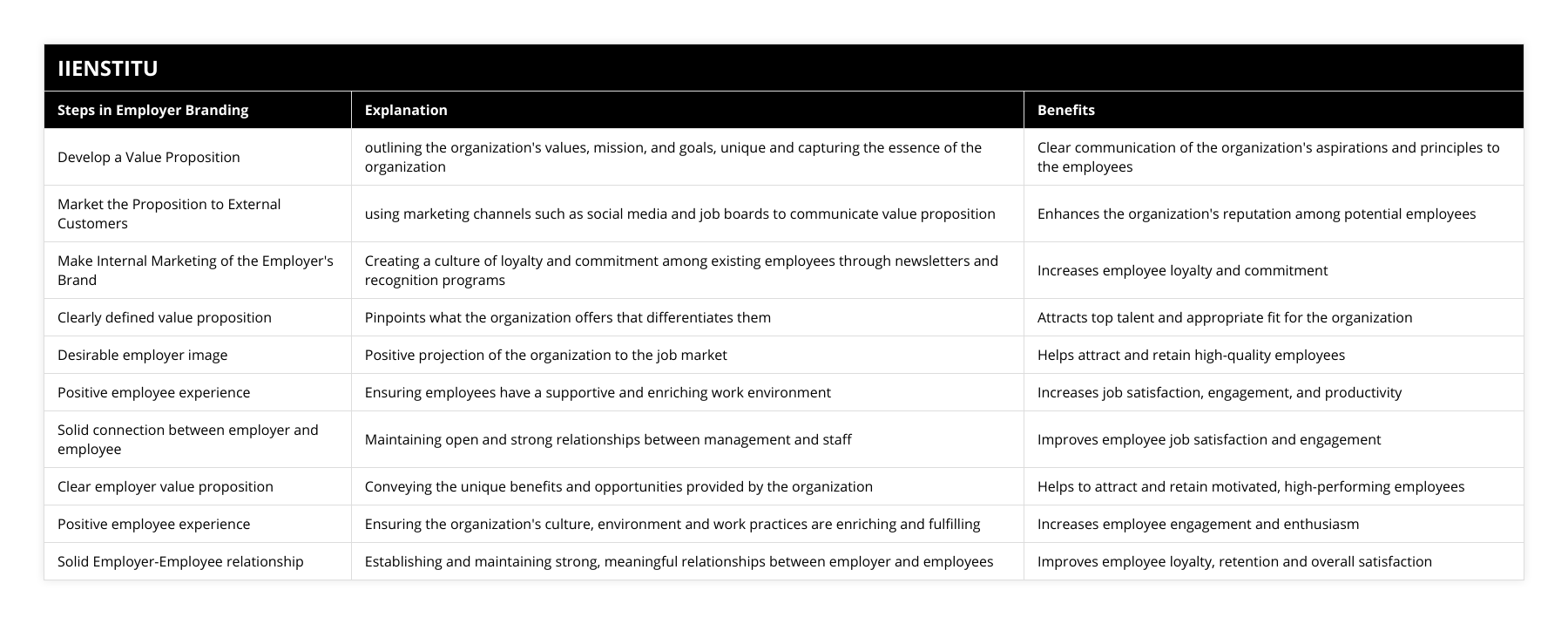
Frequently Asked Questions
What are the benefits of creating an effective employer brand?
Creating a compelling employer brand can bring numerous benefits to any organization. An employer brand is the perception of an organization as an employer that is created among current and potential employees. It is based on existing employees' experience, candidates' feedback, and the employer's communication with the public. When appropriately designed, a compelling employer brand can create a positive image of the organization and attract the right talent.
The first benefit of creating a compelling employer brand is improved recruitment. Recruiting the right people is crucial as the job market becomes more competitive. An effective brand will help attract suitable candidates and increase the chances that they will accept the job offer. It can also help to reduce turnover rates by creating a sense of loyalty and commitment among employees.
Another benefit of creating a compelling employer brand is improved employee engagement. A strong employer brand can help develop employees' sense of belonging and loyalty. It can also create a positive work environment, leading to increased productivity and efficiency.
Finally, creating a compelling employer brand can help to increase the organization's reputation in the marketplace. A strong employer brand will help to create a positive perception of the organization and can help to establish a competitive advantage. It will also help to attract potential customers and business partners, as well as increase public support.
In conclusion, creating a compelling employer brand can bring numerous benefits to an organization. It can help improve recruitment and employee engagement and increase the organization's reputation in the marketplace. Organizations must create and maintain a compelling employer brand to remain competitive in the job market.
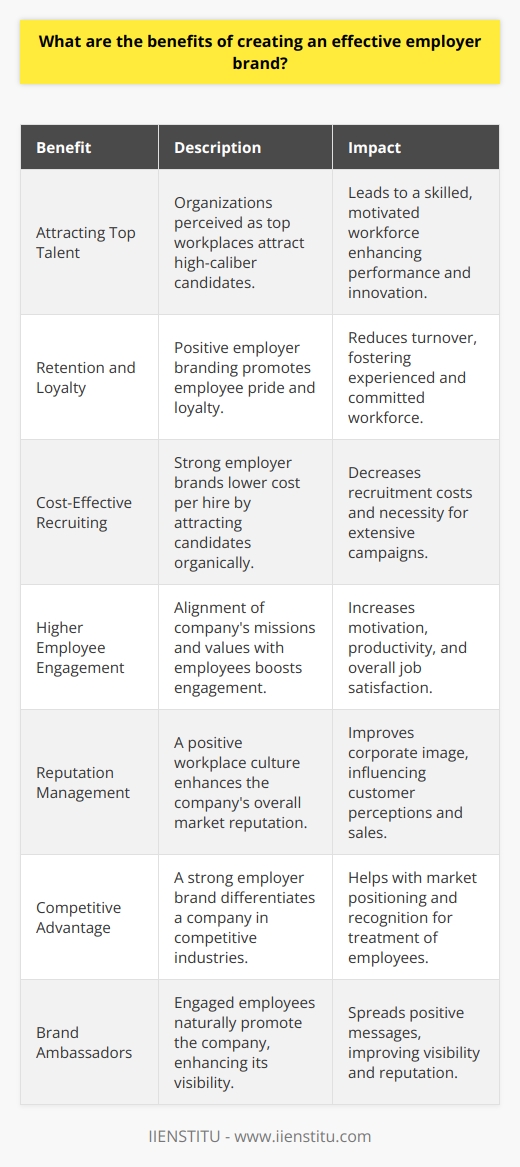
What are the steps to create an effective employer brand?
Creating a compelling employer brand is essential for any business that wants to attract and retain top talent. Employer branding is a crucial element of the overall branding strategy and can differentiate a company from its competitors. Employers use employer branding to differentiate themselves in the marketplace, attract the right talent, and create a positive workplace culture.
The first step in creating a compelling employer brand is to define the company's values. This is essential for building a strong employer brand, as it will help to clarify the company's purpose and mission. Once the values have been determined, it is important to communicate them to potential and current employees. This can be done through the company website and other public communications, such as press releases, social media posts, and job postings.
The second step is to create a clear and consistent message about the company. This should include the company's mission, values, and culture. In addition, the employer brand should be communicated through the company's website, job postings, and other materials, such as brochures and newsletters.
The third step is to ensure that the employer brand is reflected in the company's recruitment and hiring practices. This includes recruitment, job postings, onboarding, and other related activities. Again, ensuring that the company's values and culture are reflected in these processes is essential.
The fourth step is to measure the success of the employer brand. This can be done by tracking employee engagement and satisfaction as well as recruitment and hiring metrics. This will allow employers to determine if the employer brand is thriving and identify areas that need to be improved.
Finally, the employer brand should be regularly updated and maintained. This includes periodically reviewing and updating the company website, job postings, and other materials. It is vital to ensure that the employer brand is kept up-to-date and relevant to the changing needs of the business.
Creating a compelling employer brand is a complex process that requires a great deal of effort and dedication. However, it is essential for any business that wants to attract and retain top talent. By following the steps outlined above; employers can create an employer brand that will help them to differentiate themselves from their competitors, attract the right talent, and create a positive workplace culture.
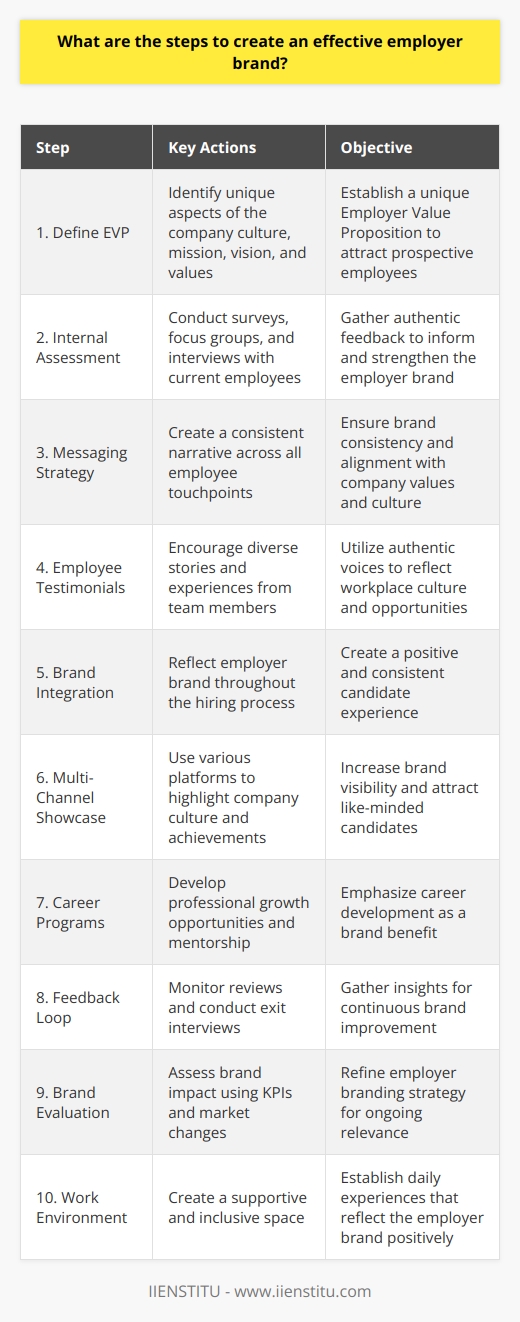
What elements should be included in a successful employer brand?
Employer branding is a crucial element in the recruitment process, and it is essential to ensure that all aspects of an employer brand are carefully considered and effectively communicated. An effective employer brand should include the following details:
1. Mission and Values:
The mission and values of an organization are a fundamental part of the employer brand. They should be clearly articulated and consistently communicated to ensure potential employees understand the organization's culture. This will help to ensure that potential candidates understand the organization's long-term objectives and the role they may play in achieving them.
2. Company Culture:
The company culture is another important factor that should be included in the employer brand. This should consist of the organizational values and beliefs and other aspects of the corporate culture that may be relevant to potential employees. In addition, it is essential to ensure that the company culture is accurately communicated to ensure potential employees understand what working for the organization will be like.
3. Employee Benefits:
Employee benefits are essential in the recruitment process and should be included in the employer brand. This may have health benefits, retirement plans, and other perks that may be offered. It is essential to ensure that potential employees know the available benefits, as this may be a deciding factor in the recruitment process.
4. Employee Engagement:
Employee engagement is a critical element of the employer brand and should be included in the employer brand. This may include initiatives such as company events, team-building activities, and other activities designed to increase employee engagement. In addition, it is essential to ensure that potential employees understand the importance of employee engagement within the organization, as this may be a deciding factor in the recruitment process.
5. Communication:
Communication is a crucial element of the employer brand and should be included in the employer brand. This may consist of the communication channels available to employees and any other initiatives that may be designed to facilitate effective communication within the organization. It is essential to ensure that potential employees know the available communication channels, as this may be a deciding factor in the recruitment process.
In conclusion, a compelling employer brand should include the mission and values of the organization, the company culture, employee benefits, employee engagement, and communication. By ensuring that these elements are included in the employer brand, organizations can ensure that potential employees have an accurate understanding of the organization and can make an informed decision about whether or not to work for the organization.
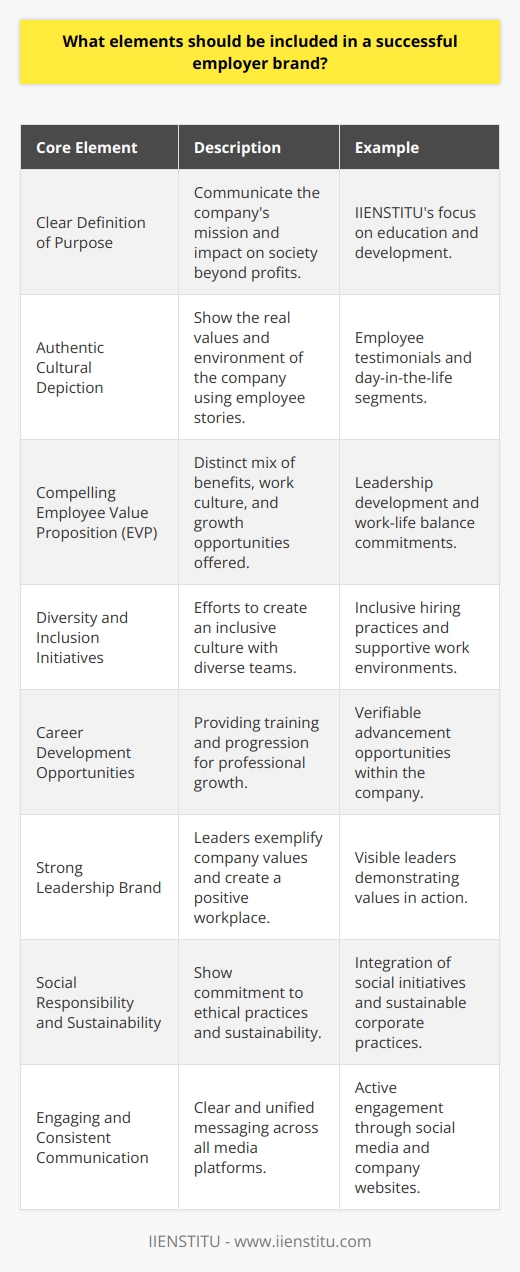
How do you create an employer brand that resonates with both current and potential employees?
Creating a Cohesive Employer Brand
Understanding Core Values
In building an employer brand that resonates with both current and potential employees, it is crucial to begin by identifying the organization's core values. These fundamental beliefs can shape the company's culture and provide a foundation for its vision and mission. A thorough analysis of the organization's strengths, history, and existing employee sentiment can help in discovering these values, serving as the basis for branding efforts.
Conveying Authenticity and Differentiation
Authenticity is a key element in creating an employer brand that accurately represents the organization and resonates with employees. Businesses must diligently work towards crafting a genuine image by ensuring that branding messages align with their core values and day-to-day practices. Focusing on unique selling points or differentiators, such as a supportive work environment or specialized training programs, can make an employer stand out and attract qualified candidates.
Involving Employees in Brand Creation
Including employees in the development and implementation of the employer brand can further enhance its authenticity and effectiveness. By soliciting employee feedback on the branding message, companies can better capture the essence of their corporate culture and improve employee buy-in. Showcasing employee success stories and testimonials can also build trust in the brand among prospective hires, demonstrating how the organization facilitates personal and professional growth.
Leveraging Digital Channels for Communication
Maximizing the use of digital channels, such as social media, websites, and blogs, to communicate the employer brand to both internal and external audiences is imperative. These platforms enable the organization to showcase their values, culture, and achievements, reaching a larger audience and inviting potential employees to engage with the brand. Providing insights into the company's work life, employee initiatives, and social events can help to create a relatable and attractive employer brand.
Maintaining Consistency and Adaptability
For an employer brand to truly resonate, it must retain a degree of consistency throughout all aspects of the employee experience. This entails ensuring that both recruitment and onboarding processes, as well as ongoing employee engagement initiatives, align with the organization's values and branding message. Simultaneously, businesses must remain adaptable to evolving industry trends, employee needs, and demographic shifts, continuously fine-tuning their employer brand to remain relevant.
In conclusion, crafting an employer brand that connects with current and prospective employees entails identifying core values, maintaining authenticity, involving employees, leveraging digital channels, and ensuring consistency and adaptability. By implementing these strategies, businesses can create a compelling and effective employer brand that attracts and retains top talent.

What are the five steps to developing a strong employer brand and ensuring it remains consistent throughout the organization?
Establishing a Robust Employer Brand
The first step in developing a strong employer brand is identifying the organization's unique value proposition (UVP). This entails analyzing the company's culture, values, and goals to establish a solid foundation. Engaging employees in this process and conducting thorough internal research can provide valuable insights into what the organization truly stands for.
Creating a Compelling Brand Identity
The next step is to design an attractive brand identity, which encompasses not only a visual representation but also a compelling narrative behind the brand. The consistent use of branding elements such as logos, color schemes, and messaging is crucial for maintaining uniformity across all channels of communication. This will enhance brand recognition and create a lasting impression on potential candidates.
Strategizing Internal and External Communication
Developing a comprehensive internal and external communication strategy is crucial for promoting employer branding. Internally, this involves sharing the employer brand story, aligning leadership expectations, and creating a supportive work culture. Externally, showcasing positive employee experiences, success stories, and achievements can appeal to potential candidates and build a robust employer brand reputation.
Implementing Brand Ambassadors
To maintain consistency, organizations must train their employees to become active brand ambassadors. Equipping them with the necessary knowledge and resources will allow them to accurately articulate the company's core values, mission, and culture. Moreover, fostering employees' pride and loyalty boosts their motivation to represent and advocate for the organization, amplifying the brand's impact.
Regularly Evaluating and Adapting
Finally, consistent monitoring and evaluation of branding initiatives are essential for identifying areas of improvement and making informed adjustments. As the company evolves, the employer brand must also adapt to remain relevant and up-to-date. Regular assessments ensure that the brand continues to resonate with the organization's goals and target audience, paving the way for sustained success.
In conclusion, the five essential steps to developing a strong employer brand involve identifying the organization's UVP, creating an appealing brand identity, devising effective communication strategies, empowering employees as brand ambassadors, and continuously assessing and refining the branding strategy. These steps help ensure that the employer brand remains consistent and fortified across the organization, increasing its ability to attract and retain top talent.

What are the 4 Ps of employer branding and how can they be utilized to create an attractive and compelling workplace?
Understanding the 4 Ps of Employer Branding
Effectively managing employer branding is essential for organizations looking to attract top talent and retain their best-performing employees. The concept of employer branding can be explored more comprehensively by understanding the '4 Ps' of the approach: purpose, promise, people, and perceptions.
Defining an Organization's Purpose
Firstly, an organization's purpose is the very foundation of its employer brand. This refers to the reasons and motivations behind the company's existence, its missions, and its overarching goals. By communicating the purpose clearly, organizations can create a sense of belonging and motivation among their employees. In turn, an attractive and compelling workplace can be established, allowing employees to connect their personal and professional goals with organizational objectives.
Establishing and Delivering Promises
Secondly, an employer's promise is crucial in setting expectations and attracting talented candidates. This encompasses the benefits, rewards, and growth opportunities offered by the organization. Ensuring that promises are delivered upon is equally important, as it will help develop a sense of trust among employees. Failing to fulfill promises can lead to dissatisfaction and an ineffective employer brand. Therefore, organizations should be transparent about their offerings and their commitment to delivering them.
Building a Brand through People
Next, people play a significant role in building a solid employer brand. The term 'people' is all-encompassing, referring to not only the existing workforce but also the leadership team, management, and prospective employees. Employer branding should focus on showcasing the right people and their expertise, while fostering a harmonious and supportive work environment. This will help in creating an appealing and dynamic workplace that attracts top talent and retains valued employees.
Managing Perceptions and Corporate Image
Finally, perceptions are another essential aspect of employer branding. This refers to both the internal and external image held of the organization. It is important to understand how various stakeholders perceive the company and strive to create and maintain a positive reputation. Effective communication, listening to feedback, and addressing concerns are all vital components in achieving this goal. By effectively managing perceptions, organizations can ensure that an attractive and compelling workplace is fostered, leading to increased engagement and higher employee retention rates.
 emphasize the importance of such frameworks in creating branding strategies that resonate with today's dynamic workforce. By mastering the delicate symphony of the 4 Ps, employers can harmonize their brand's melody, compelling the finest minds to join their orchestra, and crafting a workplace that's as magnetic as it is meaningful.](https://img.iienstitu.com/assets/blog/en/creating-an-effective-employer-brand-a-step-by-step-guide/faqs/6/images/9d173e62f9f4e534e2c0f6bbb594630d0eaea5a6.jpeg?v=2025-11-13&width=3840&quality=60&format=webp)
What are the steps to effective employer branding?
Understanding Employer Branding
Employer branding refers to an organization's identity and reputation from the perspective of potential and current employees. By developing a strong employer brand, companies can attract, engage, and retain the most qualified staff. The following steps outline the process to create an effective employer brand.
Establish Goals and Objectives
First, identify the main objectives of the employer brand. These may include reducing staff turnover, attracting top talent or improving employee satisfaction.
Assess Current Employer Brand Perception
Gather employee feedback through surveys or interviews to understand the existing perception of the company. Analyzing online reviews and social media can also provide valuable insights.
Develop a Unique Employer Value Proposition (EVP)
EVP encompasses the unique offerings of an organization that influence employees when choosing or staying with an employer. This may include career growth opportunities, inclusive work culture, progressive policies, or competitive compensation.
Communicate the Employer Brand Strategically
Create a compelling narrative that showcases the employer brand consistently across all relevant channels, such as the company website, job descriptions, and social media platforms.
Foster Employee Advocacy
Encourage employees to share positive experiences with the company, acting as brand ambassadors and reinforcing the employer brand externally.
Monitor and Measure Success
Regularly evaluate the effectiveness of the employer branding efforts using key performance indicators (KPIs), such as employee satisfaction, retention rates, or time to fill open positions.
Adjust and Improve
Make data-driven decisions and iterate on the employer branding strategy, ensuring it remains relevant and aligned with the business's overall goals and objectives.
In conclusion, a well-implemented employer branding strategy involves setting goals, assessing current perceptions, developing a unique EVP, and strategically communicating the brand. By fostering employee advocacy and measuring success, companies can continually improve their employer brand, positioning themselves as coveted employers in the market.
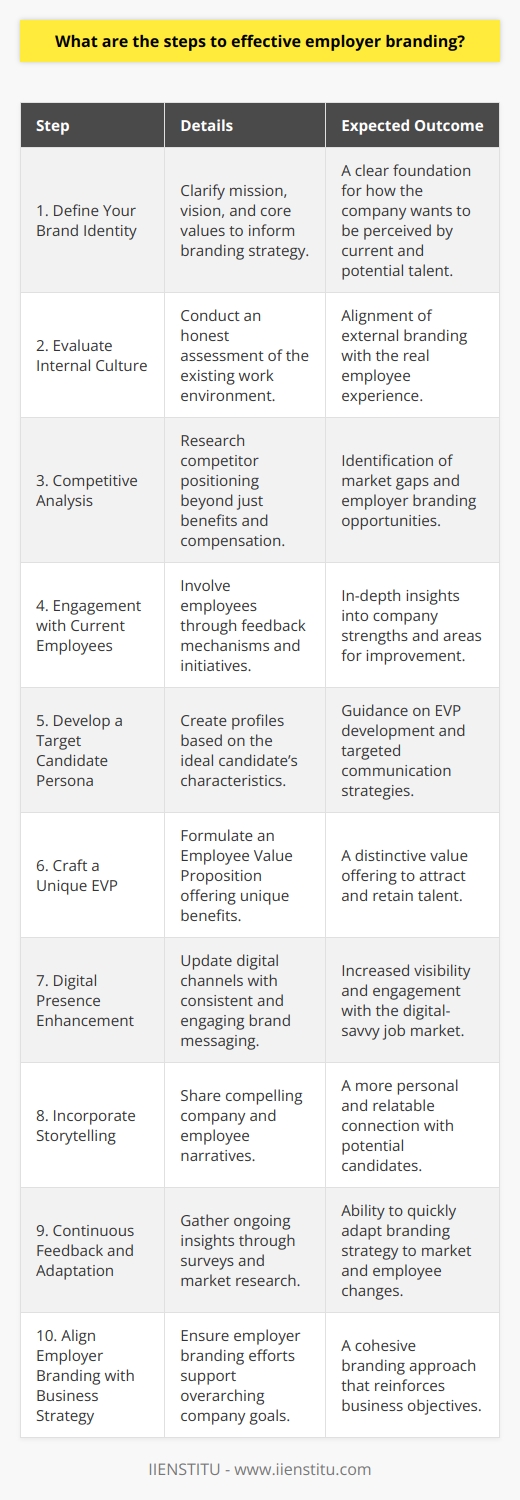
How do you create an employer brand that appeals to both current employees and prospective talent?
Understanding Employee Needs
The first step in creating an employer brand that appeals to both current employees and prospective talent is understanding their needs and desires. Conducting surveys, focus groups or one-on-one interviews, and analyzing employee data can help uncover key factors that motivate employees and attract new talent. Furthermore, comparing these findings to industry benchmarks and competitors' practices can provide insights into areas of improvement.
Aligning Organizational Values
Aligning company values with employee expectations is essential in building a strong employer brand. Demonstrating commitment to these values through continuous reinforcement and showcasing success stories helps in creating an authentic, attractive employer brand. By weaving these values into everyday practices, companies can build a sense of purpose and pride among their employees, which in turn will make the company more appealing to potential candidates.
Internal Communication and Recognition
Open and transparent communication is vital in creating a positive work environment, allowing employees to understand the organization's goals, achievements, and challenges. Sharing these details fosters trust, while dialogue and feedback channels give employees a voice in the decision-making process. Valuing and recognizing employees' contributions and achievements further strengthens the bond between the company and its workforce.
Investment in Professional Growth
A commitment to investing in employees' professional growth is a significant factor in attracting and retaining talent. Opportunities for training, development programs, skill-building workshops, and promoting internal mobility can significantly impact employee satisfaction levels. Establishing a culture that encourages and supports continuous learning contributes to a stronger employer brand, inspiring loyalty and commitment from current and prospective employees.
External Communication and Image
Presenting a strong employer brand to external audiences is crucial for attracting top talent. Leveraging social media, online forums, and employee review websites can help craft a compelling and consistent brand image. Showcasing employee testimonials, company culture, and achievements will resonate with job seekers, allowing them to envision themselves as part of the organization.
Inclusion and Diversity
Promoting an inclusive and diverse workplace demonstrates a commitment to equal opportunities while fostering innovation through varied perspectives. An environment that embraces and supports differences attracts individuals from diverse backgrounds and experiences, expanding the talent pool for prospective recruits. Companies that champion diversity in their workforce convey a sense of fairness, equality, and social responsibility, amplifying their employer brand's appeal.
In conclusion, creating an employer brand that appeals to both current employees and prospective talent involves understanding employee needs, aligning company values, enhancing internal and external communication, investing in professional growth, and fostering inclusion and diversity. By addressing these areas, organizations can build a strong employer brand that not only attracts and retains talent but also encourages employees to become dedicated ambassadors of the company.

What are the key components of a comprehensive employer branding strategy?
Defining Employer Value Proposition
A vital aspect of a comprehensive employer branding strategy is defining the employer value proposition (EVP). This refers to the unique blend of benefits and opportunities an organization offers its employees, which distinguishes it from other employers. An effective EVP communicates the organization's mission, values, culture, and career development opportunities to attract and retain the best talent.
Prioritizing Targeted Messaging
Another crucial component of an employer branding strategy is targeted messaging. The organization should prioritize creating messages that resonate with its ideal candidate profiles, showcasing the company's EVP to attract the right talent. This targeted messaging should be consistent across all recruitment channels and integrated into the overall marketing and communication strategy.
Ensuring Employee Engagement
Employee engagement plays a significant role in the success of an employer branding strategy. Ensuring that employees are engaged and satisfied with their work experience increases their likelihood of advocating for the company's brand. In turn, this can positively impact the organization's reputation as an employer, making it easier to recruit top talent.
Employing Talent Acquisition Strategies
To maximize the effectiveness of an employer branding strategy, organizations should employ robust talent acquisition strategies. This includes leveraging digital platforms like social media, job boards, and company career pages to amplify their employer brand message. Additionally, participation in career events, networking opportunities, and industry-related initiatives can further enhance the brand's reach and credibility.
Measuring and Analyzing Results
A comprehensive employer branding strategy requires ongoing evaluation and refinement. Organizations should set key performance indicators (KPIs) for their branding efforts and monitor these KPIs over time to assess the effectiveness of their initiatives. This data-driven approach allows organizations to continuously optimize their branding strategies by implementing targeted improvements.
In conclusion, a comprehensive employer branding strategy encompasses several key components, including defining the employer value proposition, prioritizing targeted messaging, ensuring employee engagement, employing talent acquisition strategies, and measuring and analyzing results. By investing in these areas, organizations can create a strong employer brand that attracts and retains top talent.
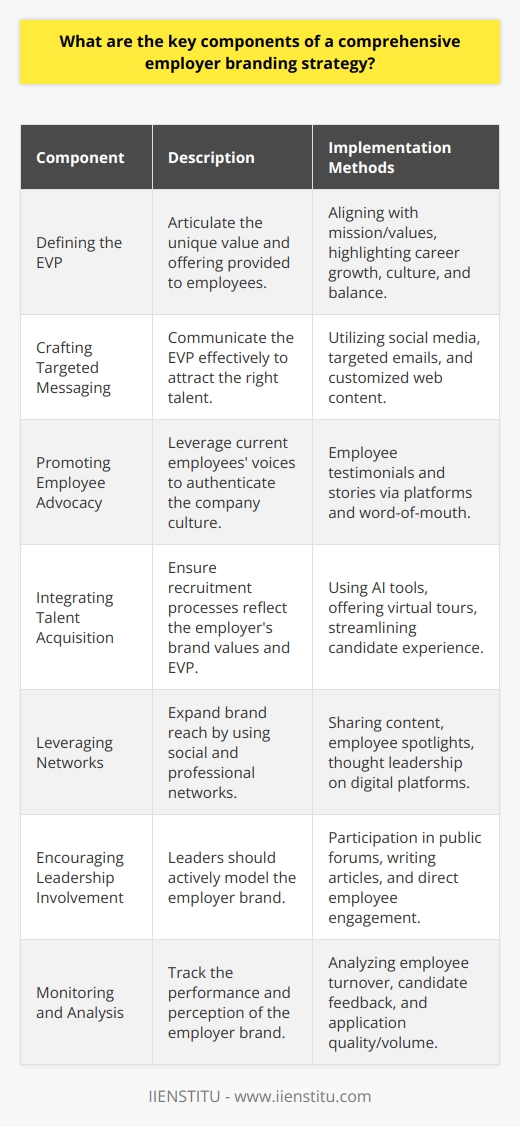
What's the first step toward creating an employer brand?
Understanding the Organization's Values and Goals
The first step toward creating a strong employer brand is to have a clear and comprehensive understanding of the organization's values, goals, and overall identity. This encompasses examining the company's mission statement, core values, and strategic objectives, as well as engaging with different stakeholders within the organization to gather their perspectives (Jiang & Iles, 2011).
Conducting Internal Assessments
Conducting internal assessments is crucial to gather insights about the current state of the organization's culture and reputation. This might involve reviewing employee feedback, conducting surveys or focus groups, and analyzing turnover rates (Backhaus & Tikoo, 2004). These assessments help identify gaps between the existing and desired employer brand image, thereby creating a solid foundation to begin the branding process.
Developing a Value Proposition
Next, the organization must develop a compelling employee value proposition (EVP) which serves as the foundation of the employer brand (Chang & Birkett, 2019). The EVP should clearly communicate what sets the company apart as an employer and what employees can expect to gain from working there. It should also align with the organization's values and strategic direction to ensure consistency and authenticity.
Creating a Clear Brand Message
Once a strong EVP is established, the organization must create a clear and consistent brand message that captures the essence of the employer brand (Mosley, 2015). This message should be communicated across all touchpoints within the employee lifecycle, including recruitment materials, onboarding processes, internal communications, and learning and development programs. This consistent messaging helps create a cohesive and coherent employer brand that resonates with both current and prospective employees.
Promoting the Employer Brand
Finally, the organization needs to develop a targeted strategy to promote the employer brand externally, leveraging various platforms and channels to reach potential candidates (Biswas & Suar, 2016). This might include partnering with universities or industry associations, participating in job fairs, or engaging in social media campaigns. Ultimately, a robust employer branding strategy should target candidate segments that align best with the organization's values and goals, yielding a higher likelihood of attracting ideal talent and building a strong workforce.
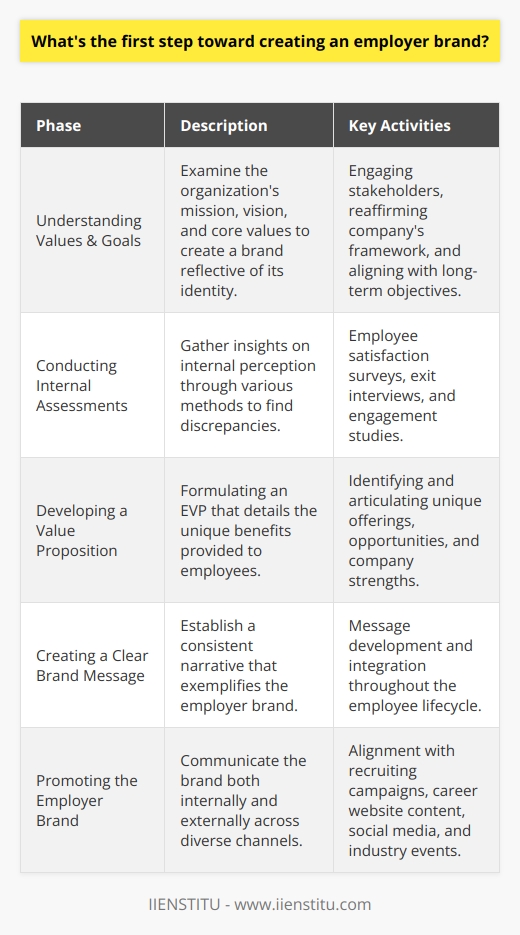
What are the 4 Ps of employer branding and how do they contribute to an effective and appealing workplace?
**Introduction to the 4 Ps of Employer Branding**
The 4 Ps of employer branding, namely Product, People, Process, and Perception, play a crucial role in shaping an organization's image, thereby attracting top talent and fostering employee satisfaction. By carefully addressing each element, employers can create an effective and appealing workplace that is conducive to productivity and success.
**Product: Offering a Compelling Value Proposition**
First, the Product aspect of employer branding concerns an organization's value proposition. A compelling and attractive proposition not only aids in talent acquisition but also helps to retain existing employees by continuously providing them with purposeful work, growth opportunities, and a competitive compensation structure. Crafting a clear and distinct value proposition allows employees to understand and align with the company's mission and values, which in turn fosters long-term loyalty and commitment.
**People: Fostering a Strong Company Culture**
Second, the People element refers to the employees within a company and the unique culture they create. Promoting diversity and inclusion, adopting flexible work policies, and providing ample professional development opportunities helps to create an inviting and collaborative work environment. When employees feel valued and supported, they are more likely to be productive, engaged, and dedicated to the organization. This positive perception of the organization among current employees can also boost employer branding through word-of-mouth and social media presence.
**Process: Streamlining Employee Experience**
The Process dimension of employer branding emphasizes creating efficient and transparent workflows and systems, which contribute to a seamless employee experience. Employees should have access to tools and resources that enable them to perform their job roles effectively and effortlessly. In addition, leadership should understand the importance of providing clear expectations, timely feedback, and opportunities for improvement. When organizational processes are streamlined, employees can focus on their core duties, leading to enhanced productivity and overall job satisfaction.
**Perception: Managing External Reputation**
Lastly, Perception deals with managing the external reputation of an organization. Employers must ensure that the company's values, mission, and culture are consistently portrayed to the public to gain trust and respect. This can be achieved by engaging with the community, showcasing corporate social responsibility, and investing in strategic public relations campaigns. Companies with a positive and well-regarded reputation will naturally attract top talent, as prospective employees will be eager to associate themselves with a respected brand.
In conclusion, the 4 Ps of employer branding—Product, People, Process, and Perception—provide a comprehensive framework for organizations seeking to create a successful and appealing workplace. Focusing on these four elements will not only help employers attract and maintain a skilled workforce but will also foster employee satisfaction and ultimately lead to enhanced organizational performance.

How do you build an employer brand that reflects the core values and culture of the organization, while also attracting top talent and maintaining loyalty among current employees?
Identifying Core Values and Culture
To build an employer brand reflecting the organization's core values and culture, it is vital to first identify those values and culture aspects that differentiate the company from competitors. Begin by conducting internal assessments, including surveys and focus groups, to gather employee insights and opinions regarding the company's identity, strengths, and unique attributes.
Developing a Compelling Employer Value Proposition (EVP)
Next, create a compelling employer value proposition (EVP) that clearly articulates the benefits, opportunities, and experiences the organization has to offer prospective employees. An effective EVP should highlight the factors that make your company an attractive workplace, thereby enabling prospective recruits to evaluate whether their career aspirations align with the company's culture.
Leveraging Communication Channels
Utilize various communication channels, such as blogs, social media, and career websites, to share authentic stories showcasing real employee experiences, corporate social responsibility initiatives, and the overall work environment. Regularly updating these platforms with engaging, value-driven content will enable potential candidates to gain an accurate understanding of the company’s culture, while also fostering a sense of pride and loyalty among existing employees.
Offering Competitive Compensation and Perks
Offering competitive compensation packages, along with unique perks and benefits tailored to your target talent pool, can significantly enhance your employer brand. Benchmark your organization's compensation, rewards, and benefits against industry or regional standards to remain attractive in a competitive talent market. Aligning your offerings with your company's core values and culture can also reinforce your employer brand.
Promoting Internal Growth Opportunities
Encouraging and supporting employee growth within the organization can improve retention rates and establish your company as an employer of choice. Ensure that policies and processes for performance evaluations, training, and development programs are transparent and aligned with the company's objectives. Top performers should be recognized and rewarded with opportunities for advancement, further reinforcing their loyalty and commitment to the organization.
In conclusion, building an employer brand that reflects the core values and culture of the organization requires a combination of clearly-defined strategic actions. Properly identifying the unique attributes of the organization, developing a compelling EVP, leveraging communication channels, offering competitive compensation and perks, and promoting internal growth opportunities all contribute to attracting top talent while maintaining loyalty amongst current employees.
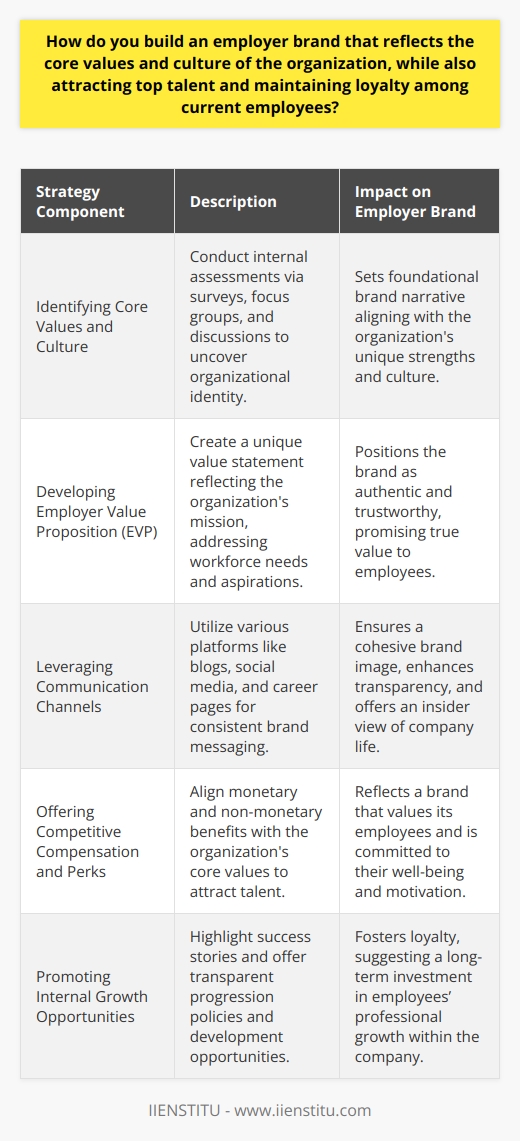
What are the crucial elements of a robust employer branding strategy, and how can they be effectively communicated to prospective talent?
Key Components of a Strong Employer Branding Strategy
Understanding the Target Audience
An essential element of an effective employer branding strategy is understanding and catering to the specific needs, wants, and values of the target talent pool. By conducting thorough research on their preferences and expectations, organizations can craft a compelling employee value proposition (EVP) that resonates with prospective employees.
Emphasizing an Authentic Culture
A robust employer branding strategy must portray an authentic and consistent company culture that exemplifies the organization's core values. By promoting real employee stories, showcasing the work environment, and encouraging open dialogue, organizations can foster a strong sense of community and belonging, ultimately attracting top talent.
Leveraging Digital Channels
In today's digital age, utilizing a variety of online channels for employer branding is crucial. From social media to career websites, organizations must present a consistent brand image across all platforms, highlighting their EVP and showcasing their workplace culture through engaging content. This approach ensures increased visibility and effectively communicates the brand message to the target audience.
Building a Positive Reputation
A critical component of a successful employer branding strategy is maintaining a positive reputation in the market. By proactively addressing negative reviews, engaging in industry events, and fostering a strong relationship with the media, organizations can enhance their credibility and attract high-quality candidates.
Engaging Current Employees
Employee engagement plays a significant role in establishing a positive employer brand. By offering ample growth opportunities, appreciating employees' efforts, and actively seeking their feedback, companies can create a thriving work environment that inspires employees to act as brand ambassadors, thereby amplifying the organization's attractiveness to prospective talent.
Measuring and Optimizing Results
Lastly, continuously monitoring and evaluating the effectiveness of an employer branding strategy is critical to its success. By analyzing key performance indicators, organizations can identify areas for improvement, making necessary adjustments to enhance their ability to attract, retain, and engage top talent. Regular assessments enable a company to remain agile and to adapt to changing market conditions.
In conclusion, a robust employer branding strategy comprises several key elements, including understanding the target audience, emphasizing an authentic culture, leveraging digital channels, building a positive reputation, engaging current employees, and continuously measuring and optimizing results. By effectively communicating these elements to prospective talent, organizations significantly increase their chances of attracting and retaining the best candidates in an increasingly competitive labor market.
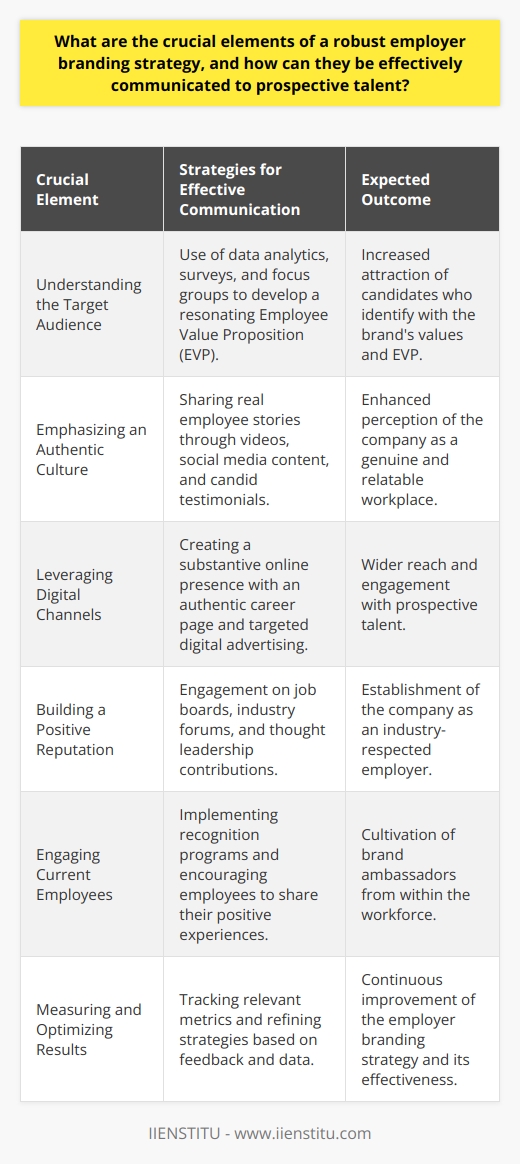
How can an organization assess the success of its employer branding efforts and make necessary improvements?
Evaluating Employer Branding Success
To assess the success of an organization's employer branding efforts, it is essential to identify the specific objectives the company aims to achieve. Examples of such objectives include attracting top talent, retaining existing employees, and improving overall employee engagement. By clearly defining these goals, organizations can design effective evaluation methods to determine the success of their employer branding initiatives.
Measuring Key Performance Indicators
One approach to evaluating employer branding success is measuring key performance indicators (KPIs). Quantifiable metrics such as the number of applicants, the time it takes to fill vacancies, employee retention rates, and employee engagement scores are useful tools in determining the effectiveness of an organization's branding efforts. Monitoring these metrics over time allows organizations to identify trends and adjust their strategies as needed.
Gathering Employee Feedback
Another essential method to assess employer branding success is gathering feedback from employees. Conducting surveys, focus groups, and exit interviews can provide valuable insights into the employee experience and perceptions of the organization's brand. This feedback can identify strengths and weaknesses in the employer branding strategy and inform necessary improvements.
Analyzing Social Media Presence
Social media platforms offer a wealth of data about an organization's brand perception among prospective and current employees. Analyzing the reach, engagement, and sentiment of social media content provides valuable information on the organization's cultural fit and reputation. This analysis can help identify areas requiring improvement and highlight successful strategies for further optimization.
Benchmarking against Industry Peers
Comparing an organization's employer branding efforts to industry peers is an effective way to determine relative success. By analyzing the strategies and outcomes of competitors, organizations can identify best practices and opportunities to differentiate their brand. This benchmarking process can serve as a valuable method of both assessment and inspiration for continuous improvement in employer branding.
Conclusion
In summary, measuring employer branding success requires a multifaceted approach, considering both quantitative and qualitative data. By defining objectives, monitoring KPIs, gathering employee feedback, analyzing social media presence, and benchmarking against industry peers, organizations can effectively assess their employer branding efforts and make necessary improvements. Ultimately, this ongoing evaluation process will enable organizations to better attract, retain, and engage top talent.
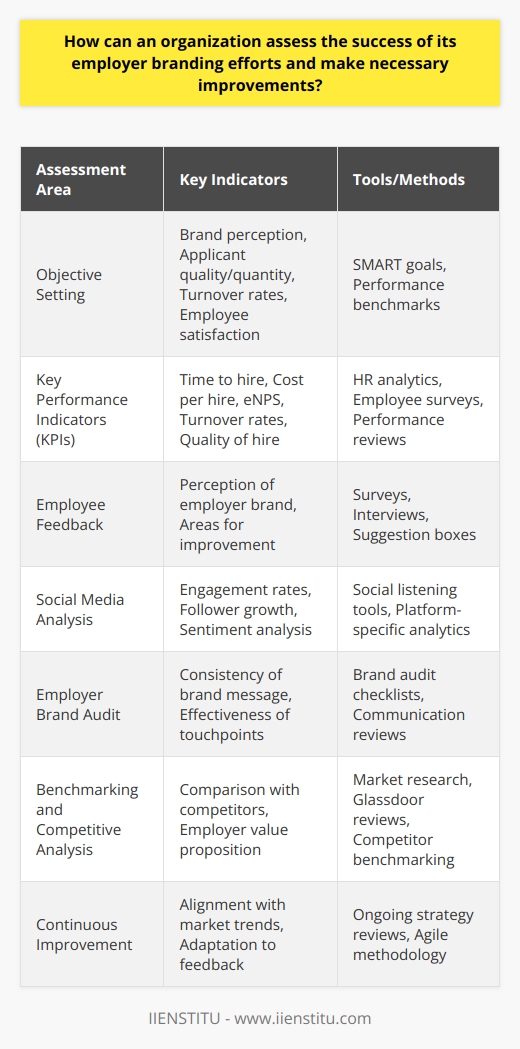
In what ways can an organization ensure that its employer brand remains consistent and appealing to both current employees and potential candidates over time?
Develop a Strong Organizational Culture
A strong organizational culture not only helps in maintaining consistency in the employer brand but also enhances employee engagement. By fostering shared values, norms, and practices within the organization, employees get a sense of belonging and identity. This, in turn, makes the employer brand appealing to both current employees and potential candidates.
Implement Clear Communication Practices
Effective communication ensures that employees are informed about the organization's objectives, expectations, and progress. This transparency creates a sense of trust and credibility in the employer brand. Moreover, by promoting open discussions and feedback, organizations can continue to evolve and remain appealing over time.
Offer Training and Development Opportunities
Organizations can retain the interest of their employees and attract new talent by offering relevant training and development opportunities. Such initiatives enable employees to grow professionally, feel valued, and contribute positively towards the organization's success. This, in turn, reflects positively on the employer brand, making it more appealing to both current and potential employees.
Promote Diversity and Inclusion
Embracing diversity and promoting inclusive working environments contribute significantly towards an organization's attractiveness as an employer. By valuing differences, organizations can create a sense of belonging and make employees feel valued, which in turn, strengthens the employer brand.
Recognize and Reward Employee Efforts
Acknowledging employees' hard work and rewarding them accordingly is essential for the employer brand to remain appealing. Recognition helps to motivate employees, demonstrate appreciation, and improve employee satisfaction. By doing so, organizations maintain a positive image and attract potential candidates.
Adopt a Flexible Work-Life Balance
Promoting a healthy work-life balance and offering flexible work options greatly enhance an organization's appeal as an employer. These practices not only cater to employees' well-being but also contribute to their productivity and the overall success of the organization.
Regularly Monitor Employer Brand Perception
By consistently assessing internal and external employer brand perceptions, organizations can identify areas requiring improvement. Gathering feedback from current employees, potential candidates, and online resources allows organizations to keep their employer brand relevant and appealing.
In conclusion, maintaining a consistent and attractive employer brand requires continuous effort from organizations. By focusing on establishing a strong organizational culture, enhancing communication, offering development opportunities, promoting diversity, recognizing employee contributions, and giving work-life balance, organizations are better equipped to retain current employees and attract potential talent. Monitoring employer brand perceptions and addressing key areas of concerns will ensure a sustained appeal both internally and externally.
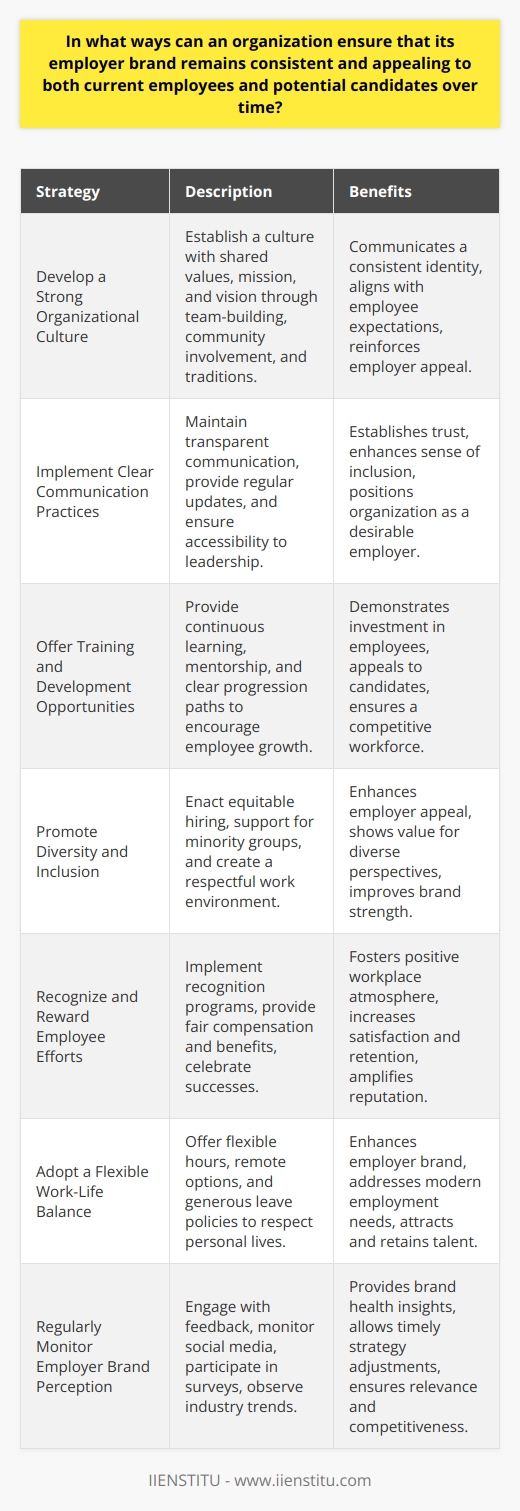
What are the five steps to developing a strong employer brand?
**Understanding Brand Importance**
Employer branding is essential in attracting and retaining top talent in today's competitive job market. Developing a strong employer brand involves five key steps, which include defining the brand, promoting the company culture, differentiating from the competition, measuring success, and constant improvement.
**Defining the Brand**
Firstly, it is important to define the employer brand by establishing a clear and unique value proposition. The value proposition is a statement outlining the organization's culture, values, and benefits, which distinguishes it as an attractive employer. This helps in setting the foundation for shaping perceptions about the company among both current and potential employees.
**Promoting Company Culture**
Secondly, organizations need to promote their company culture to attract talent that aligns with their ethos. This can be achieved through various channels such as company websites, social media accounts, and employee testimonials. Showcasing real-life examples of the work environment, employee interactions, and testimonials help in creating an authentic perception of the company.
**Differentiating from Competitors**
The third step in developing a strong employer brand is to differentiate the organization from its competitors. Highlighting unique characteristics and offerings, such as flexible work arrangements, career development opportunities, and employee recognition programs, can distinguish a company from other employers in the market. Crafting a distinct message about the company's special attributes will make it stand out to potential candidates.
**Measuring Success**
It is crucial to monitor the effectiveness of the employer branding efforts continuously. Key performance indicators such as offer acceptance rates, employee retention rates, and quality of applicants should be tracked to assess the success of the branding initiatives. Regular evaluation of the employer brand can also provide insights for ongoing adjustments or enhancements.
**Constant Improvement**
Lastly, a strong employer brand requires constant improvement. Organizations must be proactive in researching new trends and best practices, seeking employee feedback, and addressing any areas of concern. Continuous improvement demonstrates a commitment to employee satisfaction and drives positive growth in the company's reputation as an employer of choice.
In conclusion, organizations must prioritize these five steps in order to establish a strong employer brand, which is essential in attracting and retaining top talent. A well-defined value proposition, promotion of company culture, differentiation from competitors, measuring success, and constant improvement will ensure that an organization's employer branding strategy is effective and prominent in the job market.
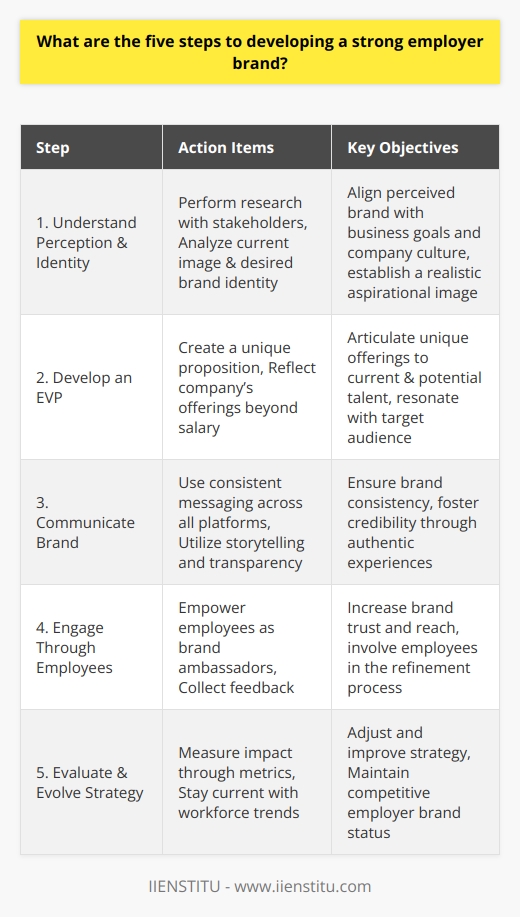
What are the 4 Ps of employer branding?
Four Pillars of Employer Branding
Product Management
The first P of employer branding is Product Management. This aspect highlights the importance of an organization's offerings, such as their products or services. It focuses on creating a strong value proposition for potential employees by consistently developing and improving the organization's offerings. Emphasizing the unique characteristics or benefits an organization provides helps to differentiate itself from competitors in the eyes of potential employees.
Price Strategy
The second P, Price Strategy, refers to the compensation package organizations offer their employees. This includes not only salary but also the various benefits and incentives that are part of the overall compensation package. In order to be competitive, an employer must attract and retain top talent by providing attractive salaries and benefits tailored to the needs and expectations of their target employee group. Elements such as flexible working hours or opportunities for personal and professional development should be taken into account when designing an organization's compensation strategy.
Promotional Activities
The third P, Promotional Activities, involves the communication and visibility of the employer's brand. This entails promoting the organization's culture, values, and what sets it apart from competitors. Various communication channels should be utilized, such as social media, job boards, and the company website, to reach a broader audience. Participating in industry events and collaborating with educational institutions can also aid in effectively promoting the employer brand and establishing its reputation in the market.
Place Strategy
Lastly, Place Strategy refers to the company's approach to ensuring its work environment aligns with the organization's employer brand. This involves creating a physical space that reflects the sought-after elements in line with the company's values and culture. Factors such as location, office layout, and design are crucial components of the overall employee experience. The company's place strategy should be aimed at fostering a conducive work atmosphere that attracts and retains top talent.
In conclusion, the 4 Ps of employer branding encompass product management, price strategy, promotional activities, and place strategy. These pillars work together to create a cohesive and appealing employer brand, effectively attracting and retaining top talent in competitive markets. Organizations that invest in crafting a strong employer brand will benefit from a loyal and motivated workforce, ultimately driving business success.
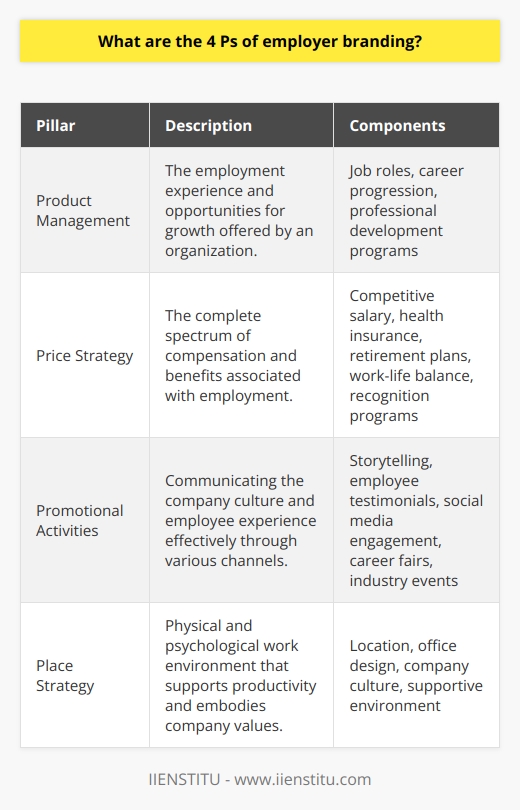
What are the three core steps in employer branding?
Subheading: Identifying and Defining the Employer Brand
The first core step in employer branding is a thorough identification and definition of the organization's employer brand. This requires investigating the values, work culture, and employment experience that the organization offers, ultimately shaping a distinctive employer value proposition (EVP) that sets it apart from competitors. The EVP encapsulates the unique attributes and benefits that employees can expect from the company, thus driving both talent attraction and employee engagement.
Subheading: Communicating the Employer Brand
Once the employer brand is well-defined, the second core step involves effectively communicating it to internal and external audiences. This process requires the development of a comprehensive employer branding strategy, which encompasses various marketing and communication channels such as social media, company websites, employee testimonials, and recruitment materials. It is crucial for organizations to convey a consistent and authentic message about their employer brand so that potential candidates and current employees can develop a strong perception of what it is like to work for the company.
Subheading: Monitoring and Updating the Employer Brand
The third core step in employer branding is an ongoing process of monitoring and updating the employer brand. Considering that the job market, industry trends, and talent preferences can shift over time, it is essential for organizations to evaluate the effectiveness of their employer branding strategy and make adjustments as needed. This involves analyzing various performance indicators, such as employee engagement, retention rates, and recruitment metrics, to determine the success of the employer branding efforts. By regularly reviewing and updating the employer brand, companies can enhance their appeal to prospective employees and adapt to the ever-changing talent landscape.
